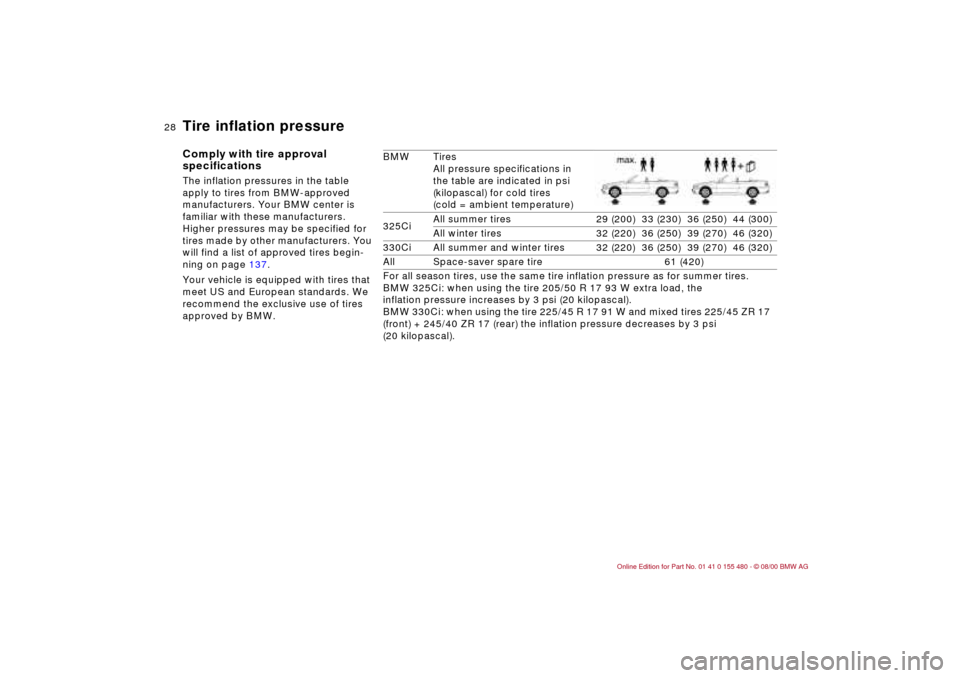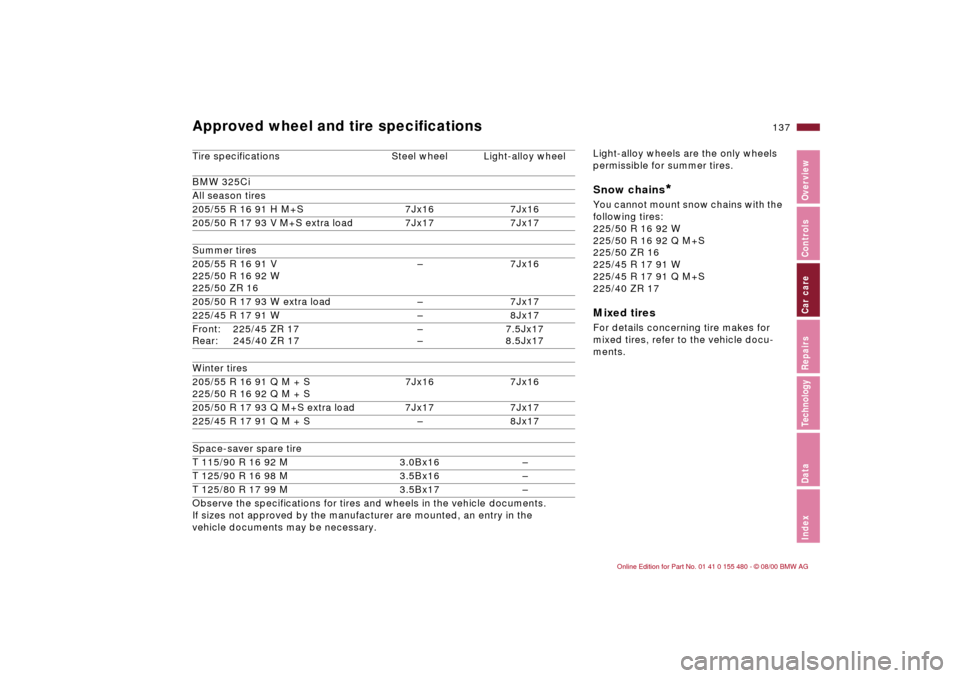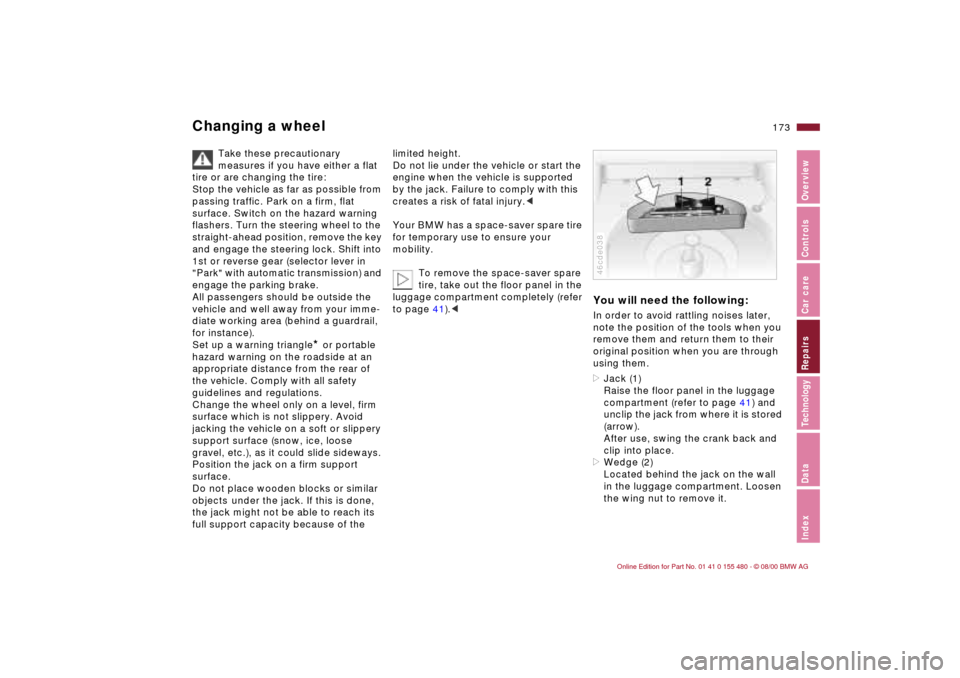2001 BMW 330Ci CONVERTIBLE spare tire
[x] Cancel search: spare tirePage 27 of 215

27n
IndexDataTechnologyRepairsCar careControlsOverview
Fuel specifications Tire inflation pressure The engine uses lead-free gasoline
only.
Required fuel:
Premium Unleaded Gasoline,
min. 91 AKI.
AKI = Anti Knock Index
Do not use leaded fuels. The use
of leaded fuels will cause perma-
nent damage to the system's oxygen
sensor and the catalytic converter.<
Proper inflation pressures are on a
sticker attached to the B-pillar and
visible with the driver's door open.Check tire pressuresOn the next page you will find all the tire
pressure and ambient air temperature
specifications stated in the units usually
used in your country (psi; kilopascal).
For vehicles with Tire Pressure Control
(RDC):
After correcting the tire inflation pres-
sure, reactivate the system. Refer to
page 91.462de197
Check tire inflation pressures,
including the space-saver spare
tire, regularly, at least every two weeks
and before beginning any extended
driving. Otherwise, incorrect tire pres-
sure can lead to tire damage and acci-
dents.<
Page 28 of 215

28n
Tire inflation pressure Comply with tire approval
specificationsThe inflation pressures in the table
apply to tires from BMW-approved
manufacturers. Your BMW center is
familiar with these manufacturers.
Higher pressures may be specified for
tires made by other manufacturers. You
will find a list of approved tires begin-
ning on page 137.
Your vehicle is equipped with tires that
meet US and European standards. We
recommend the exclusive use of tires
approved by BMW.BMW Tires
All pressure specifications in
the table are indicated in psi
(kilopascal) for cold tires
(cold = ambient temperature)
325CiAll summer tires 29 (200) 33 (230) 36 (250) 44 (300)
All winter tires 32 (220) 36 (250) 39 (270) 46 (320)
330Ci All summer and winter tires 32 (220) 36 (250) 39 (270) 46 (320)
All Space-saver spare tire 61 (420)
For all season tires, use the same tire inflation pressure as for summer tires.
BMW 325Ci: when using the tire 205/50 R 17 93 W extra load, the
inflation pressure increases by 3 psi (20 kilopascal).
BMW 330Ci: when using the tire 225/45 R 17 91 W and mixed tires 225/45 ZR 17
(front) + 245/40 ZR 17 (rear) the inflation pressure decreases by 3 psi
(20 kilopascal).
Page 92 of 215

92n
Tire Pressure Control (RDC)
*
In the event of a flat tireIf there is a tire failure with loss of pres-
sure, the indicator lamp comes on with
a red lamp. In addition, an acoustic
signal is sounded.
If this occurs, reduce vehicle speed
immediately to stop the vehicle in a safe
location. Avoid hard brake applications.
Do not oversteer. Replace the wheel
and flat tire.
The space-saver spare tire is
provided for temporary use only in
the event of a flat tire. It does not have
RDC electronics and is not monitored.<
RDC cannot alert you to severe
and sudden tire damage caused
by external factors.<
Have the tires changed by your
BMW center.
Your BMW center has been trained to
work with the RDC system and is
equipped with the necessary special
tools.<
System interferenceLocal devices using the same radio
frequency can interfere with the RDC.
The yellow indicator lamp will come on
during the malfunction.
The indicator lamp also comes on
>in the event of a system fault.
>if a wheel is mounted without RDC
electronics.
>if additional wheels with RDC elec-
tronics are on board.
Please contact your BMW center for
additional information.
Page 132 of 215

132n
Information for your safetyThe factory-approved radial tires are
matched to the vehicle and have been
selected to provide optimum safety and
driving comfort on your vehicle.
It is not merely the tire's service life, but
also driving comfort and Ð above all
else Ð driving safety that depend on the
condition of the tires and the mainte-
nance of the specified tire pressure.
Incorrect inflation pressure is a frequent
cause of tire damage. It also signifi-
cantly influences the roadholding ability
of your BMW.
Be sure to check the tire inflation
pressure Ð including the space-
saver spare tire Ð on a regular basis, i.e.
at least twice a month and before
beginning a longer trip. Refer to
page 28. If this is not done, incorrect
tire pressures can cause driving insta-
bility and tire damage, ultimately
resulting in an accident.<
Tire tread Ð tire damageInspect your tires frequently for tread
wear, signs of damage and for foreign
objects lodged in the tread. Check the
tread depth.
Tread depth should not be allowed to
go below 0.12 in (3 mm), even though
the legally specified minimum tread
depth is only 0.063 in (1.6 mm). At a
tread depth of 0.063 in (1.6 mm), tread
depth indicators (arrow) in the tread-
groove base indicate that the legally-
permissible wear limit has been
reached. Below 0.12 in (3 mm) tread
depth, there is an increased risk of
aquaplaning, even at relatively
moderate speeds and with only small
amounts of water on the road.390de331
Do not drive on a deflated (flat)
tire. A flat tire greatly impairs
steering and braking response, and can
lead to complete loss of control over
the vehicle.
Avoid overloading the vehicle so that
the permitted load on the tires is not
exceeded. Overloading can lead to
overheating and increases the rate at
which damage develops inside the
tires. You could have a blowout as a
result.
Unusual vibrations encountered during
normal vehicle operation can indicate
tire failure or some other vehicle defect.
This is also true for irregularities in the
vehicle's handling characteristics, such
as a pronounced tendency to pull to the
left or right. Should this occur, respond
by immediately reducing your speed.
Proceed carefully to the nearest BMW
center or professional tire center, or
have the vehicle towed in to have it and
its tires inspected.
Tire damage (up to and including blow-
outs) can endanger the lives of both the
vehicle occupants and other road
users.<
Tire inflation pressure Tire condition
Page 134 of 215

134n
Tire replacement Tire rotationTire ageThe date on which the tire was manu-
factured is indicated by the code on the
sidewall:
DOT ... 4100 means that the tire was
manufactured in week 41of 2000.
BMW recommends the replacement of
all tires when the tires are no more than
6 years old, even if a tire life of 10 years
is possible.
Spare tires over 6 years old should be
used only in case of emergency. A tire
in this condition should be replaced by
a new tire immediately, and should not
be mounted together with new tires.
Between the axlesThe tread wear patterns at the front end
differ from those at the rear Ð the actual
patterns will vary according to indi-
vidual driving conditions. In the inter-
ests of safety and maintaining optimal
handling characteristics, tire rotation is
not recommended.
If a proposed interaxle rotation of tires
is based on economic considerations,
one should consider whether the costs
for the rotation are likely to be recap-
tured by any increase in the service life
of the tires that might be realized. In
principle, tire rotation must be
performed at short intervals (maximum
3,000 miles/5,000 km). Consult your
BMW center for more information.
Should you decide to rotate the tires,
it is essential to comply with the
following:
Rotate tires on the same side only,
since braking characteristics and road
grip could otherwise be adversely
affected.
Following rotation, the tire inflation
pressure should always be corrected.If different tire sizes are mounted
on the front and rear axles (refer
to page 137), the wheels may not be
rotated from one axle to the other.<
Page 137 of 215

137n
IndexDataTechnologyRepairsCar careControlsOverview
Approved wheel and tire specifications Tire specifications Steel wheel Light-alloy wheel
BMW 325Ci
All season tires
205/55 R 16 91 H M+S 7Jx16 7Jx16
205/50 R 17 93 V M+S extra load 7Jx17 7Jx17
Summer tires
205/55 R 16 91 V
225/50 R 16 92 W
225/50 ZR 16Ð 7Jx16
205/50 R 17 93 W extra load Ð 7Jx17
225/45 R 17 91 W Ð 8Jx17
Front: 225/45 ZR 17
Rear: 245/40 ZR 17Ð
Ð7.5Jx17
8.5Jx17
Winter tires
205/55 R 16 91 Q M + S
225/50 R 16 92 Q M + S7Jx16 7Jx16
205/50 R 17 93 Q M+S extra load 7Jx17 7Jx17
225/45 R 17 91 Q M + S Ð 8Jx17
Space-saver spare tire
T 115/90 R 16 92 M 3.0Bx16 Ð
T 125/90 R 16 98 M 3.5Bx16 Ð
T 125/80 R 17 99 M 3.5Bx17 Ð
Observe the specifications for tires and wheels in the vehicle documents.
If sizes not approved by the manufacturer are mounted, an entry in the
vehicle documents may be necessary.
Light-alloy wheels are the only wheels
permissible for summer tires.Snow chains
** * *
You cannot mount snow chains with the
following tires:
225/50 R 16 92 W
225/50 R 16 92 Q M+S
225/50 ZR 16
225/45 R 17 91 W
225/45 R 17 91 Q M+S
225/40 ZR 17Mixed tiresFor details concerning tire makes for
mixed tires, refer to the vehicle docu-
ments.
Page 138 of 215

138n
Approved wheel and tire specificationsTire specifications Steel wheel Light-alloy wheel
BMW 330Ci
All season tires
205/50 R 17 93 V M+S extra load 7Jx1717 7Jx17
Summer tires
205/50 R 17 93 W extra load Ð 7Jx17
225/45 R 17 91 W Ð 8Jx17
Front: 225/45 ZR 17
Rear: 245/40 ZR 17Ð
Ð7.5Jx17
8.5Jx17
Winter tires
205/50 R 17 93 Q/V M+S extra load 7Jx17 7Jx17
225/45 R 17 91 Q M + S Ð 8Jx17
Space-saver spare tire
T 125/80 R 17 99 M 3.5Bx17 Ð
Observe the specifications for tires and wheels in the vehicle's documents.
If you install tire sizes not approved by the manufacturer, an entry in the
vehicle documents may be necessary.
Light-alloy wheels are the only wheels
permissible for summer tires.Snow chainsYou cannot mount snow chains with the
following tires:
225/45 R 17 91 W
225/45 R 17 91 Q M+S
245/40 ZR 17Mixed tiresFor details concerning tire makes for
mixed tires, refer to the vehicle docu-
ments.
Page 173 of 215

173n
IndexDataTechnologyRepairsCar careControlsOverview
Changing a wheel
Take these precautionary
measures if you have either a flat
tire or are changing the tire:
Stop the vehicle as far as possible from
passing traffic. Park on a firm, flat
surface. Switch on the hazard warning
flashers. Turn the steering wheel to the
straight-ahead position, remove the key
and engage the steering lock. Shift into
1st or reverse gear (selector lever in
"Park" with automatic transmission) and
engage the parking brake.
All passengers should be outside the
vehicle and well away from your imme-
diate working area (behind a guardrail,
for instance).
Set up a warning triangle
* or portable
hazard warning on the roadside at an
appropriate distance from the rear of
the vehicle. Comply with all safety
guidelines and regulations.
Change the wheel only on a level, firm
surface which is not slippery. Avoid
jacking the vehicle on a soft or slippery
support surface (snow, ice, loose
gravel, etc.), as it could slide sideways.
Position the jack on a firm support
surface.
Do not place wooden blocks or similar
objects under the jack. If this is done,
the jack might not be able to reach its
full support capacity because of the
limited height.
Do not lie under the vehicle or start the
engine when the vehicle is supported
by the jack. Failure to comply with this
creates a risk of fatal injury.<
Your BMW has a space-saver spare tire
for temporary use to ensure your
mobility.
To remove the space-saver spare
tire, take out the floor panel in the
luggage compartment completely (refer
to page 41).<
You will need the following:In order to avoid rattling noises later,
note the position of the tools when you
remove them and return them to their
original position when you are through
using them.
>Jack (1)
Raise the floor panel in the luggage
compartment (refer to page 41) and
unclip the jack from where it is stored
(arrow).
After use, swing the crank back and
clip into place.
>Wedge (2)
Located behind the jack on the wall
in the luggage compartment. Loosen
the wing nut to remove it.46cde038